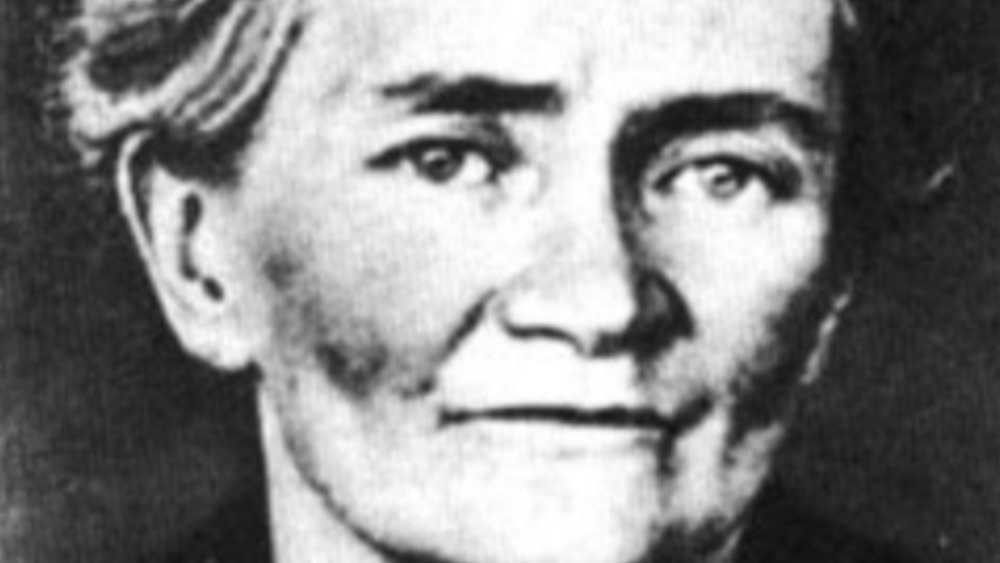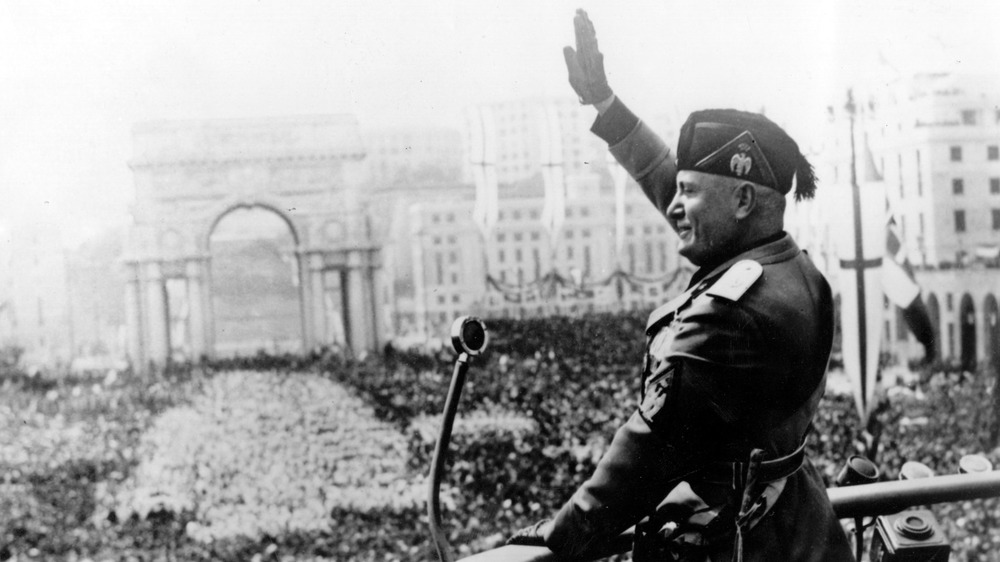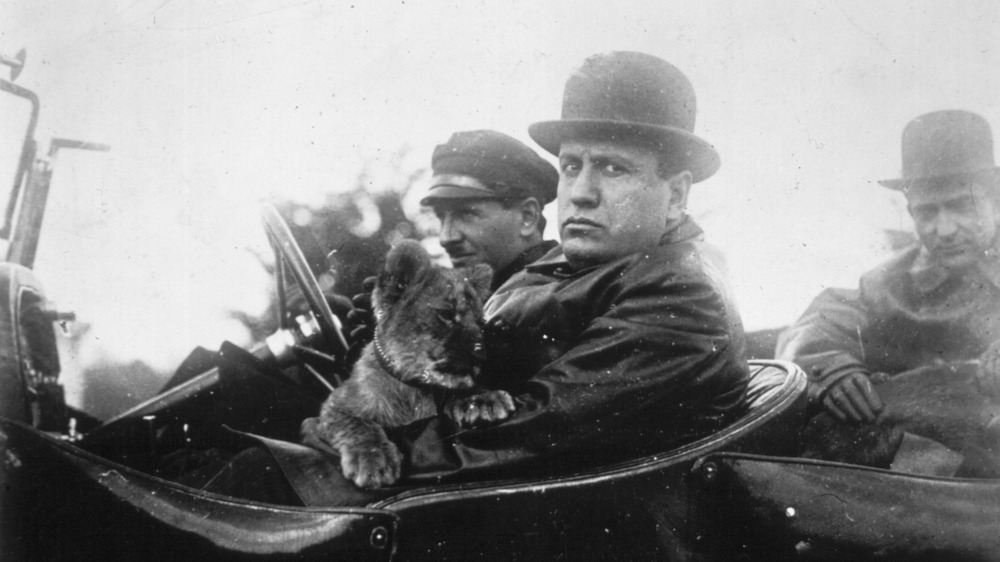The Tragic Truth About The Woman Who Nearly Assassinated Mussolini
On April 7, 1926, the Italian fascist dictator Benito Mussolini survived what would be the closest of four assassination attempts on his life. As Public Radio International reports, it took place in Rome's Piazza del Campidoglio just after the strongman had made a speech to a roaring crowd of supporters, and the person who pulled the trigger was a 50-year-old woman from Ireland. Violet Gibson got close enough to fire on Il Duce (Italian for "The Leader) at point-blank range, but unfortunately at that very moment, his attention was drawn to a group of students had struck up a fascist song paying tribute to him. He turned his head, and she succeeded in only lopping off a bit of his nose, rather than altering the course of history. She tried to fire again, but her gun jammed. Gibson was taken down by furious supporters of the fascist leader, who would have done serious damage to her had the police not pulled them off of her.
An attempt on the life of someone like Mussolini definitely doesn't go unnoticed. The event made headlines across the globe, but Gibson's act of defiance was soon forgotten and went mostly unremembered for nearly a century. However, after a film, biography, and radio documentary about Violet Gibson were released in the 2010s, Ireland is finally making moves to honor her contribution to history.
Mussolini's rise to power
Born in 1883, Mussolini was a difficult, unruly child. According to Britannica, he was a bully who got expelled from several schools for stabbing classmates with his penknife. He grew into a young man with charisma and great rhetorical skill. He read philosophers like Kant, Nietzche, Hegel, and others, but had the classic fascist ability to pick and choose what he liked and what he disliked from them to form his own incoherent political ideology. He worked as a political journalist and propagandist and made a name for himself among the Italian working class. Although he initially opposed Italy's involvement in World War I, he ended up changing his philosophy, becoming staunchly nationalist, and went off to fight.
When he returned in 1918, Italy was facing terrible economic and political crises, and he called for the advent of a dictator who could put the country back on its feet. He soon said in a speech that he'd gladly volunteer for the job. His magnetism and rhetoric united everyone, from republicans to unionists to disenchanted socialists to outright anarchists, who came together to form fascist militias. In October 1922 he spoke before 40,000 fascists in Naples, threatening to march on Rome if the government didn't hand over power to them. When the government didn't yield, he and 25,000 fascists did just that, forcing the King Victor Emmanuel III to hand power over to Mussolini.
World leaders were glad Mussolini was ok
People like Violet Gibson could tell where such an ideology was headed, or at least had a bad feeling about it. But that wasn't necessarily the case with people in power across the globe. For some reason, people tend to ignore or tolerate fascists until it's too late (see: World War II), and at this stage in the game, most world leaders were glad that the man who had elbowed his way into the dictatorship like a bully in a schoolyard had survived the attack. Everyone from U.S. President Calvin Coolidge to King George of England to the heads of state of Ireland, France, and Germany — even Pope Pius XI — all sent Mussolini news of their relief that he was okay.
Mussolini himself wasn't too happy that a woman — and a foreign woman, at that — had gotten so close to killing him. He appeared in public with a bandaged nose just hours after the attempt on his life. Wanting to avoid any and all publicity on the matter, he forwent trying Gibson in Italy and sent her to England. He played up the fact that Gibson had suffered from mental health issues in an attempt to nullify any claims she may have had to a legitimate political opinion. The reception she got from her family and British and Irish authorities was not much different.
Violet Gibson's own parents silenced the repercussions of her act
According to biographer Frances Stonor Saunders, author of the 2010 book The Woman Who Shot Mussolini, the would-be assassin's family was not happy about what she had done. Violet came from a privileged family. Her father was lord chancellor of Ireland, the highest-ranking legal authority in the country. He was also a protestant, and he was already miffed at his daughter for having converted to Catholicism and gone to France to champion pacifist causes.
Upon her arrival in England, Gibson was met by British doctors who quickly deemed her "lucidly insane," which was pretty much a made-up mental illness that families and husbands used at the turn of the century to get rid of women they considered to be troublemakers. Gibson did have a history of mental health issues, but the diagnosis really served to cancel out her legitimate reason for doing what she did. It was also enough to send her to a mental institution for the rest of her life. Although she wrote authorities like Winston Churchill and Princess Elizabeth (now Queen Elizabeth) to ask for help with her release, they were never replied, and she died in the institution in 1956. She was 79 years old. The headstone at her grave bore only her name and dates of her birth and death, and not one family member went to her funeral. "Even in her death, she was a great embarrassment," Stonor Saunders told PRI.
Other assassination attempts on Mussolini
Gibson's attempt on Mussolini's life was actually the second in what would end up being four. Historian J. Bowyer Bell recounts the first of these attempts in his 1979 book Assassin: Theory and Practice of Political Violence. It occurred on November 4, 1925, when a former deputy of the Socialist party, Tito Zaniboni, planned to snipe Mussolini from a hotel room during a speech he was to give. Zaniboni was betrayed by a friend who was actually a double agent, though historians believe he may have been set up by Mussolini's administration in order to justify its move to consolidate power afterwards. In September 1926, anarchist Gino Lucetti tried to take out the dictator by tossing a bomb at his limo.
According to Executed Today, the fourth unsuccessful attempt came in October of that same year, when 15-year-old Anteo Zamboni tried to shoot Mussolini while he was riding in a motorcade. He was brutally beaten and stabbed to death by fascist supporters of Mussolini just after the failed attempt. The city of Bologna honored his act by naming a street after him.
Mussolini was executed by partisans on April 28, 1945, in a small town north of Milan. His body was taken to Milan the following day and hung by the feet alongside that of his mistress Claretta Petacci and several other fascists in a public square.
Honoring Violet Gibson's act of resistance
Stonor Saunders and other historians believe that the reason Violet Gibson's assassination attempt went under the radar for so long is because she was a woman. She only became aware of Gibson from a one-sentence mention of an Irish woman shooting the dictator in a biography of him. "She should be celebrated as a brave woman, as a political radical, as an antifascist," said Stonor Saunders. "And if she was mad, well, she still saw something before anyone else did." Siobhán Lynam, producer of the radio documentary on Gibson, said, "Certainly, she would have been remembered. I think it was just indicative of how women were treated in history."
Now authorities in Ireland are making moves to right that wrong. In December 2020, Dublin City Councilman Mannix Flynn put forth a motion that would make Gibson's act more widely known and give her "her rightful place in the history of Irish women and the rich history of the Irish nation." He compared the silencing of her story in the 20th century to what he called the "cancellation generation" of today.
Irish filmmaker Barrie Dowdall has also tried to honor Gibson's legacy with the film Violet Gibson, the Irish Woman Who Shot Mussolini, released in March 2020. Dowdall aims to tell Gibson's story in theaters across the globe, and says that's what her family now wants, as well. "They want her to be seen as a woman who stood up against the sins of fascism."





